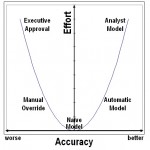 Are you a prefectionist when it comes to forecasting, or any kind of data analysis? If so, perhaps my SAS colleague Gary Cokins can cure you.
Are you a prefectionist when it comes to forecasting, or any kind of data analysis? If so, perhaps my SAS colleague Gary Cokins can cure you.
Gary is a prolific writer and contributor in the performance management field, and describes himself as a "ready-fire-aim" kind of guy. By this he means that he can stop analyzing when the information is good enough to gain insights or make decisions.
In a blog post "The Perils of Analysts Demanding Perfection and Precision" on AllAnalytics.com, Gary argues that speed and agility trumps slow and deliberate study, and I tend to agree. In forecasting you cannot expect perfection, so why knock yourself out pursuing the unachievable?
 The value in a forecast, or any other type of analytical endeavor, is to discover something that helps us make better decisions and achieve better outcomes. The value is in the improvement. But we have to be reasonable and balance our efforts with the likely payback.
The value in a forecast, or any other type of analytical endeavor, is to discover something that helps us make better decisions and achieve better outcomes. The value is in the improvement. But we have to be reasonable and balance our efforts with the likely payback.
As in the Accuracy vs. Effort chart, a little extra effort may deliver most of the achievable benefits. While a lot of extra effort may deliver very little incremental value.
Less than perfect analysis does not mean it should be "flawed, misleading, or indefensible." This is not an apology for careless work. Rather, the message is that "perfection can be the enemy of the good," improvement is the key, and just being better is often good enough.

1 Comment
Absolutely, quality always counts better than quantity. A little, but smart and effective work is beneficiary than that of long and tidy, but ineffective work. You must try to do everything with a perfection, doesn't matter if it take some extra time. This is the key point of success.